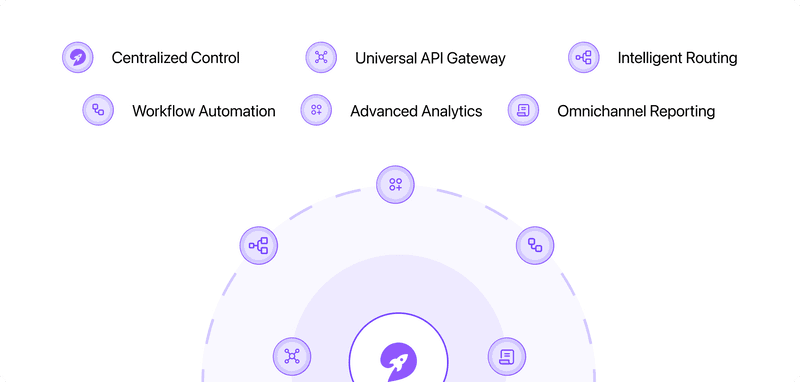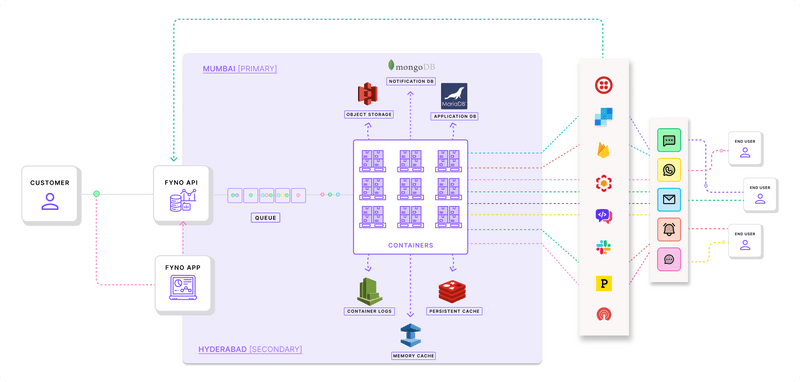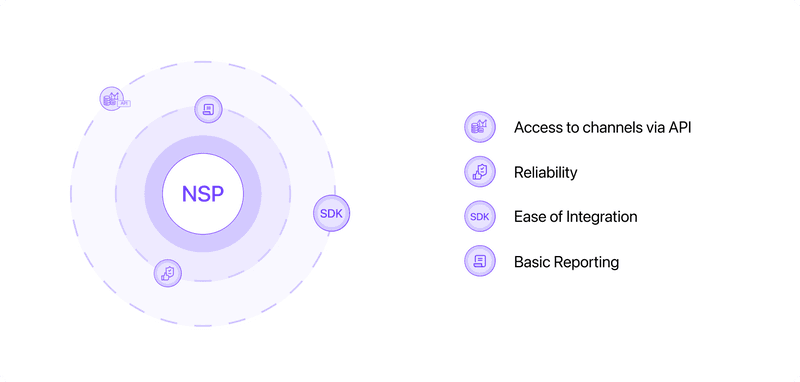Contents
Introduction
You did it! You've done everything in your power to set up the perfect notification infrastructure. You've integrated Exotel and ValueFirst for SMS; Meta and Aisensy for WhatsApp; and Sendgrid for email. But something still feels off.
Messages sometimes don't reach the right person on the right channel or at the right time, leading to missed updates and delayed responses. Costs are piling up, new features and code changes eat into your development sprints, and getting a clear picture of your communication performance feels impossible. And worst of all, your notification set up is just not delivering the results you need.
So, what's missing? The answer might be more complex than you think. You need a system that allows you to seamlessly manage multiple service providers, sync data in a centralized location, has a robust queuing system, established failover protocols, and efficiently handles rate limiting.
If you're wondering if such a solution exists, that's where a notification orchestrator like Fyno comes into the picture. It does everything you wish for and more.
If you're thinking, “What's the difference between a notification orchestrator and the service providers I already use?”, the answer is: quite a lot!
Let's break it down. In this blog post, we'll look at the difference between a notification service provider and an orchestrator, and understand why you require a notification orchestrator to unlock the true power of your customer communication.
Who is a notification service provider?
Notification service providers (NSPs) are the backbone of digital communication for businesses. They act as the delivery agents for your messages. They simplify the technical aspects of sending messages to your customers through multiple channels.
Key features offered by an NSP
- Access to channels via API: NSPs offer APIs for various channels to send notifications.
- Reliability: Businesses depend on NSPs to ensure their messages reach their intended audience promptly and securely.
- Ease of Integration: NSPs usually provide APIs and SDKs to streamline the integration process into your existing apps and systems.
- Basic Reporting: You'll likely have access to basic delivery metrics to help you gauge the performance of your notifications.
Think of NSPs as a courier service. They take your message (the notification) and get it delivered to the right address (SMS, email, etc.).
What makes working with NSPs challenging?
Despite the value they offer, NSPs have their own set of challenges. Here they are:
- Multiple APIs and Dashboards: NSPs are not “omnichannel,” by nature. Managing each channel usually requires separate APIs and dashboards. This means more integrations, more juggling between platforms, and a less-than-seamless experience for you.
- No Unified Visibility: Tracking the performance of notifications across different platforms often involves disparate logs and reporting systems, making it difficult to gain a holistic view of delivery success.
- Volume-Driven Model: Many NSPs operate as resellers focused primarily on maximizing the volume of messages sent rather than optimizing the effectiveness of each notification.
- Limited “Omnichannel” Capabilities: While NSPs often market themselves as omnichannel, the reality is that their focus is always on individual channels. Behind the scenes, there are often separate teams, product lines, and even entirely different systems handling SMS, email, WhatsApp, etc. This means they lack the ability to truly optimize your communication strategy by intelligently choosing the best channel based on cost, customer preferences, and message importance.
NSPs are indispensable, but their focus is on the delivery mechanism itself, not the overall strategy of where, when, and how the message should be sent. They don’t have failover mechanisms, geographical segmentation for sending messages, or a centralized hub to manage all the notification templates.
Who is a notification orchestrator?
A notification orchestrator is like a conductor at a symphony. It goes beyond simply delivering individual notifications and focuses on the bigger picture – ensuring all your communication channels work together to create a seamless, personalized experience for your customers.
Key features offered by a notification orchestrator

Here's what sets a notification orchestrator apart:
- Centralized Control: A notification orchestrator offers a single hub for managing all your notification channels and providers. It means no more juggling multiple APIs or dashboards.
- Universal API Gateway: Seamlessly integrates into your existing tech stack. Quickly connect new channels, providers, and sync data with ease.
- Intelligent Routing: The orchestrator determines the most effective channel (SMS, email, push, etc.) based on factors like cost, customer preferences, and the notification type itself. This saves money and improves the customer experience.
- Workflow Automation: Orchestrators allow you to create automated, multistep communication flows involving multiple channels and NSPs. For example, a signup confirmation email from service provider A followed by an SMS for important updates sent by service provider B is possible with a notification orchestrator.
- Personalization: Uses customer data to craft highly relevant notifications containing names, purchase history, and other dynamic details that boost engagement.
- Advanced Analytics: Offers in-depth reports about your notification performance. Understand what works, what doesn't, and use that data to continuously improve your strategy.
- Omnichannel Reporting: Allows you to create customizable reports that consolidate data from all your communication channels. These reports provide the insights needed to make critical business decisions and eliminate the need for hundreds of man-hours of manual analysis.
Why Orchestrators Will Always Outpace NSPs?
Notification orchestrators, like Fyno, have a fundamental advantage – they're focused on building a powerful communication middleware. It's engineering-first, aimed at solving the complexities of managing multiple channels and maximizing the impact of every message.
On the other hand, traditional NSPs operate as resellers, driven by a volume-based, commodity business model. Their focus is maximizing the number of notifications sent, prioritizing price above all else. This leaves little room to innovate and truly optimize the end-to-end communication experience. As a result, they lack the incentive and often the resources to build the intelligent, holistic solutions that businesses truly need.
Here's a more in-depth look at why a notification orchestrator will always outpace NSPs on the technology front:
- Focus on the Big Picture: Orchestrators are designed to analyze the entire communication landscape. They prioritize optimizing channel selection, building seamless workflows, and extracting actionable insights – not just pumping out more notifications.
- Agility and Innovation: Not being tied to the volume of a single channel allows orchestrators to be more nimble. They can quickly adapt to new technologies, customer preferences, and changing best practices.
- Solving the Real Problem: Orchestrators understand that simply sending more messages isn't the solution. They focus on ensuring the right messages reach the right customers in the most effective way, ultimately making every notification count.
Why do you need a Notification Orchestrator like Fyno?

In today's crowded digital environment, simply sending notifications isn't enough. To truly connect with your customers, you require intelligent solutions that ensure your messages get noticed and drive engagement. Here's where Fyno shines:
- Opti-channel and Ready: Fyno allows you to implement intelligent opti-channel strategies. It analyzes customer preferences, usage patterns, and message types to determine the most effective channel for each interaction. This maximizes the likelihood of your messages being actually seen and acted upon.
- Prioritizes Customer Preferences: Fyno respects your customers' preferences. We make it easy to tailor communication channels based on individual choices and notification types. This builds a positive brand experience and increases customer loyalty.
- Optimized Resource Allocation: Stop sending notifications blindly across all platforms! Fyno optimizes channel usage for specific scenarios, helping you reduce communication costs significantly.
- Improved Deliverability: Our intelligent routing and failover systems make sure your notifications get through, even when a primary channel experiences issues. No more missed communications, no more frustrated customers.
- Consistent Branding: Fyno allows you to manage all notification templates and brand messaging in a single place, even when sending across many channels. This ensures customers have a smooth and recognizable experience, no matter how they're hearing from you.
- Data-Driven Insights: Our detailed analytics reveal how different channels perform under various circumstances. This empowers you to continuously optimize your communication strategy, identify trends, and adapt to the ever-evolving preferences of your customer base.
- Reduced Operational Overhead: Say goodbye to the chaos of individually managing multiple vendor accounts and APIs.Fyno centralizes control and simplifies integrations, freeing up engineering resources to focus on your core product.
Fyno isn't just about sending messages; it's about unlocking the true power of personalized, optimized communication. We help you reach the right customers, on the right channels, at the right time – transforming every notification into a meaningful connection.



